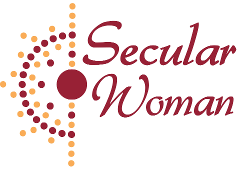Over the course of Women’s History Month, Secular Woman was pleased to run a series of articles written by women in the secular community on women’s history that was of interest to them. Below is a roundup of all the articles we published.
Women’s Contributions to Science Fiction Literature
Just imagine: the twenty-first century, a time in which all people across the Terran globe enjoy lives of equality, peace, and freedom. A time in which discrimination based on gender, race, and culture is a thing of a dark and distant past. A time in which secular humanism guides all people to treat each other fairly on the home planet and on colonies on distant worlds. And, if you can, just imagine a time in which the achievements and interests of men and women are held in equal esteem and made available to all…
Herstory of U.S. Women’s Right to Vote
The struggle for enfranchisement in the United States, a woman’s right to vote, actually began in 1848 at the Seneca Falls Convention, led by Lucretia Mott, Elizabeth Cady Stanton, and Susan B. Anthony (Judy Pehrson NY Times 2001). The Declaration of Sentiments adopted at the convention demanded the right to vote, as well as equal rights in education, industry, the professions, political office, marriage, personal freedom, control of property, guardianship of children, making of contracts, the church and in the leadership of all moral and public movements…
It took around seventy years of relentless organizing, struggle, and solidarity for women in America to win the right to vote in 1920…
Lucy (Lucía) Eldine González Parsons was a woman of Hispanic, Native American, and African American heritage, married to a white Southerner who would later become one of the Haymarket Martyrs; a woman who fought against specific oppressions of women and people of color, but who also believed that class oppression was the cause of all other oppressions; a woman who, over the course of her life, would be a socialist, an anarchist, and lastly, a communist…
Life without choices is simple. As a young woman, when faced with what seemed to me to be an overwhelming question: What am I going to do with my life? — although I knew that the possibilities were practically unlimited, I made the choice to narrow my options by devoting my life to Jesus as an evangelical Christian…
The Strong Atheist Women who Led History
Women have played a vital role in the historic forward movement of the Atheism. The impression is often given in society that atheists have always been men, and they have led the charge, but the reality when uncovered is something completely different. It was women who pushed back religion first…
The history of women in STEM fields–science, technology, engineering, and mathematics—is a history of women overcoming gender discrimination. A number of recent studies have highlighted the gender disparity in these career fields. The US National Science Foundation’s 2013 “Women, Minorities, and Persons with Disabilities in Science and Engineering” report notes that while women have studied STEM subjects in greater numbers since the early 1990s, and more women graduate from college than men, women still earn far fewer STEM degrees than men…
If Clara Schumann Had Only Been a Man!
Although Clara Wieck Schumann was a world-renowned concert pianist whose career spanned over 60 years and whose influence is still felt today in concert repertoire, the piano keyboard which forms the bottom border of the doodle almost seems like an afterthought. The focal point of the doodle is a woman so thoroughly surrounded by her children that they are literally hanging off her body and hampering her freedom of movement. Even a woman like Clara Schumann, who had managed to carve out a bit of personal fame in a thoroughly masculine world, was ultimately depicted primarily in the role which her patriarchal culture insisted was the only legitimate one for women…
One of the biology teachers who was going to be required to teach the EVILUTION chapter was a classy young lady by the name of Susan Epperson. The AEA asked her to be the plaintiff in the case they were going to bring against the state law…
